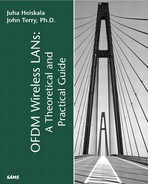MAC Frame Processing
The role of the MAC layer is to build valid TDMA/TDD MAC frames. TDMA/TDD MAC constructs frames based on the information elements and their formats given earlier in this chapter. Three parallel running processes can be identified:
Scheduler
Transmission and reception process
Control information exchange between MAC entities
Scheduler is an algorithm that assigns the transmit and receive slots for MT, but its implementation is beyond the scope of the standard and this chapter. Its implementation is entirely up to the device manufacturer as long as all the rules given in the standard and described shortly in this chapter are followed.
Access Point
Before being able to start transmitting a MAC frame, the access point and the central controller have to calculate the frame composition according to the rules given earlier. After that, it can prepare and transmit the BCH, FCH, and ACH in appropriate PDU trains. A BCH contains the position and length of its associated FCH as well as the position and the number of the RCHs. With IEs of the FCH, it transmits resource grants for the transmission of PDUs in the logical channels of this frame. The IEs can also contain an indication of empty parts of a frame.
Next the AP/CC prepares an ACH for every sector. Depending on the number of sectors, the ACH is either part of the Broadcast PDU train or part of the FCH-and-ACH PDU train. ACHs are followed by PDUs from logical channels in downlink phase. The order and the location of the PDUs and logical channels are according to the current frame composition indicated in the FCH. If the CC is involved in direct mode operation, it also transmits PDUs from logical channels in the direct link phase.
After downlink and direct link transmissions, the AP/CC receives and processes the PDUs transmitted by the terminals in the uplink phase. If the CC is involved in direct mode operation, it also receives and processes the PDUs meant for itself which are transmitted by another terminal in the direct link phase.
At the end of the MAC frame, the AP/CC receives and processes PDUs transmitted by the terminals in the RCH.
Mobile Terminal
MAC frame processing in an MT is much more straightforward and simple than in an AP. While the AP has to determine the schedule to the MAC frames, the MT acts according to the generic and specific control information transmitted by the AP.
First, in the MAC frame, the MT receives and processes the BCH and the FCH. It evaluates the FCCH with respect to the logical and transport channels relevant to it. After that, if the MT has used the RCH in the previous frame, it evaluates the ACH to get feedback from the usage of the random channel. The final phase in reception mode of the MT is to receive and process PDUs transmitted either by the AP/CC during the downlink phase or by other MTs during the direct link phase. After receiving all the scheduled transmissions to it, the MT prepares to transmit PDUs from logical channels at the scheduled time. First in time are the transmissions in direct link. Finally after the uplink transmission the MT may access the RCH if needed.
To close, the HiperLAN/2 MAC is an efficient method for data transport, which provides a specified capacity resource for each user. This features makes it attractive for delay-sensitive traffic types such as streaming video or audio. In contrast, the IEEE 802.11 MAC is better suited for delay insensitive traffic types with large packet length. Since the overhead of the medium access protocol is independent of packet length, the frame efficiency—the ratio of the data bytes to the total frame length—increases as the packet length increases.
